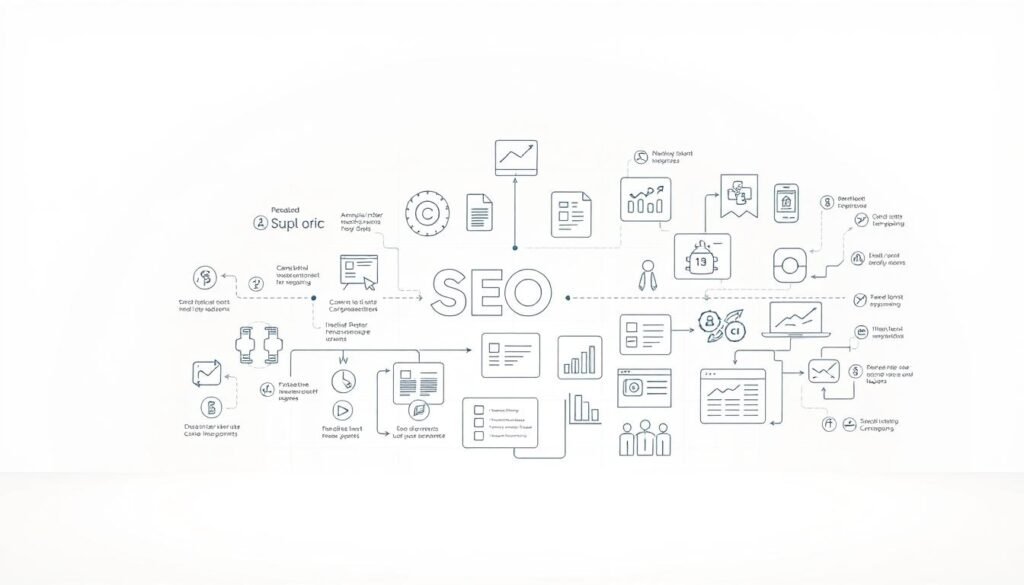What are the roles of a web developer in today’s digital economy? These professionals build the digital backbone of modern businesses. They combine coding expertise with creative problem-solving to craft websites that engage users and drive results. With employment in this field growing 13% by 2030, web developers are critical to organizational success in our tech-driven world.
Day-to-day tasks include writing code, optimizing site performance, and collaborating with designers or project managers. Developers ensure websites meet client needs while staying within budget and deadlines. Their work bridges technical functionality with intuitive design, creating seamless experiences for users.
Specializations like front-end, back-end, and full-stack development offer varied career paths. As technology evolves, developers continuously adapt to new tools and frameworks. This adaptability makes them invaluable in shaping how businesses operate online.
Table of Contents
ToggleKey Takeaways
- Web development careers are projected to grow 13% through 2030
- Developers balance technical coding with user-centered design principles
- Collaboration with cross-functional teams ensures project success
- Multiple specializations allow for tailored career paths
- Continuous learning is essential due to evolving technologies
Understanding the World of Web Development
In today’s digital landscape, crafting online experiences requires a blend of technical precision and creative vision. This field extends far beyond basic coding—it shapes how businesses connect with audiences through dynamic platforms.
Defining Web Development and Its Scope
Web development combines programming languages with design principles to build interactive websites and applications. Modern solutions involve:
- Frontend systems for user interfaces
- Backend architecture for data management
- Marketing strategies for audience engagement
- Database optimization for performance
Early websites served as digital brochures. Today’s platforms handle real-time transactions, personalized content, and cross-device compatibility. Browser-based tools now power 78% of business operations through cloud solutions.
Emerging Trends in a Digital Age
The industry evolves rapidly to meet new demands. Progressive web apps (PWAs) now deliver app-like experiences without downloads. Artificial intelligence automates tasks like code debugging and user behavior analysis.
Mobile-first approaches dominate, with 63% of web traffic coming from smartphones. Developers prioritize responsive layouts and accelerated loading speeds. Voice search optimization and API integrations are becoming standard practices for modern solutions.
Key Responsibilities of a Web Developer
Behind every functional website lies meticulous coding and strategic planning. Professionals in this field combine technical expertise with analytical thinking to deliver solutions that perform under real-world conditions.
Writing, Testing, and Debugging Code
Developers craft solutions using languages like JavaScript and Python while adhering to clean coding standards. Rigorous testing occurs through three phases:
| Phase | Purpose | Tools Used |
|---|---|---|
| Unit Testing | Verify individual components | Jest, PHPUnit |
| Integration Testing | Check module interactions | Selenium, Cypress |
| User Acceptance | Validate real-world usage | BrowserStack, UserTesting |
Continuous debugging ensures smooth operation across devices. One senior engineer notes: “Finding errors early saves 40% of post-launch troubleshooting time.”
Ensuring Website Functionality and SEO Implementation
Developers optimize sites for both users and search engines. Key actions include:
- Implementing responsive design frameworks
- Compressing images for faster loading
- Adding schema markup for better search visibility
Regular performance audits maintain 95%+ uptime for critical business platforms. This technical upkeep directly impacts conversion rates and brand credibility.
Core Skills and Technologies for Web Developers
Effective web solutions demand expertise across multiple technical domains. Modern professionals combine coding fluency with specialized tools to create responsive, data-driven platforms.
Programming Languages and Frameworks
HTML structures content, while CSS styles it. JavaScript adds interactivity through features like dynamic menus and real-time updates. Popular frameworks accelerate workflows:
- React for component-based UIs
- Angular for enterprise applications
- Node.js for server-side operations
Asynchronous programming lets sites handle multiple tasks simultaneously. This prevents page freezes during data fetches or complex calculations.
Database Management and Version Control
Storing information efficiently requires SQL expertise for relational systems like MySQL. NoSQL databases like MongoDB manage unstructured data at scale. Developers use:
- PostgreSQL for complex queries
- Firebase for real-time updates
- Git for tracking code changes
Version control systems prevent conflicts when teams edit files concurrently. One commit message mistake could cost hours – proper tracking saves 22% of collaboration time according to GitHub metrics.
The Importance of User Experience and Design Integration
Great websites balance visual appeal with technical precision. This harmony emerges when developers and designers align their expertise to solve real user needs. Their partnership transforms static concepts into dynamic digital experiences.
Collaborating with Designers
Designers craft visual blueprints, while developers translate them into functional code. Weekly sync meetings ensure alignment on:
| Designer Focus | Developer Focus |
|---|---|
| Color schemes | CSS implementation |
| Layout mockups | Responsive breakpoints |
| Animation concepts | JavaScript execution |
One designer explains: “Shared prototyping tools let us preview designs across devices before coding begins.” This workflow reduces revisions by 35% according to recent industry surveys.
Implementing Responsive and Accessible Interfaces
Modern interfaces adapt to smartphones, tablets, and desktops automatically. Developers use media queries to adjust layouts while maintaining:
- Readable text sizes
- Touch-friendly buttons
- Consistent navigation
Accessibility features like screen reader support and keyboard navigation aren’t optional – they’re ethical necessities. Proper contrast ratios and ARIA labels make sites usable for 26% of adults with visual impairments.
Performance remains key. Optimized code ensures pages load in under 2 seconds, keeping users engaged. Balancing aesthetics with speed separates good sites from great ones.
Exploring Front-End, Back-End, and Full-Stack Roles
Digital landscapes demand specialized skills, creating distinct paths in web creation. Three primary specialties shape how applications function and engage users. Each role requires unique expertise while contributing to cohesive digital solutions.
Differentiating Developer Specialties
Front-end developers craft visual interfaces using HTML, CSS, and JavaScript. They transform design mockups into interactive elements like navigation menus and forms. Popular frameworks like React and Vue.js help build dynamic components efficiently.
Back-end specialists work behind the scenes with servers and databases. They write APIs using Python or Ruby and manage data flow between users and systems. Security protocols and server optimization form their daily focus.
| Specialization | Key Tools | Output Focus |
|---|---|---|
| Front-End | React, Angular, Sass | User interaction |
| Back-End | Node.js, MySQL, Django | Data processing |
| Full-Stack | MERN Stack, GraphQL | End-to-end solutions |
Full-stack developers bridge both worlds, managing projects from concept to deployment. They troubleshoot cross-system issues and ensure seamless integration between layers. One professional notes: “Mastering both ends lets you see how pieces connect – that’s where innovation happens.”
Career paths vary by specialization. Front-end roles suit visually-minded problem solvers, while back-end attracts logic-driven thinkers. Full-stack positions offer versatility but require constant skill updates. Salaries range from $75k for entry-level to $130k+ for senior roles across specialties.
what are the roles of a web developer
Successful digital solutions emerge through structured processes and adaptive execution. Professionals manage intricate workflows from initial client meetings to post-launch optimizations, ensuring every component aligns with strategic goals.
Technical Duties Across the Development Spectrum
Daily operations span multiple project stages. Core activities include:
| Phase | Key Tasks | Collaboration Points |
|---|---|---|
| Planning | Requirement analysis, tech stack selection | Client workshops, stakeholder alignment |
| Development | Code writing, API integration | Designer syncs, QA check-ins |
| Deployment | Server configuration, load testing | DevOps coordination, security audits |
| Maintenance | Bug fixes, performance updates | User feedback reviews, analytics monitoring |
Agile methodologies guide these efforts. Daily standups and sprint retrospectives keep teams aligned. One project manager notes: “Developers who understand business objectives deliver solutions 27% faster.”
Bridging the Gap Between Design and Functionality
Translating visual concepts into functional code requires technical finesse. Developers analyze design mockups to identify feasible animations and responsive layouts. They balance creative aspirations with loading speeds and cross-browser compatibility.
Weekly cross-departmental reviews prevent misalignment. Designers present color schemes while engineers demonstrate prototype interactions. This collaboration ensures aesthetic elements don’t compromise site performance.
Documentation maintains continuity across phases. Version-controlled code comments and update logs help teams track changes efficiently. Regular client demos provide opportunities for course corrections before final delivery.
Collaboration and Communication in Web Development Teams
Building exceptional digital products requires more than technical skills – it demands orchestrated teamwork. Developers operate at the intersection of code, design, and business strategy, translating abstract ideas into functional solutions through coordinated efforts.
Working with Project Managers and Stakeholders
Clear communication bridges technical possibilities with organizational goals. Daily standup meetings align priorities across departments. Developers break down complex workflows using visual aids like flowcharts or interactive prototypes.
Agile methodologies structure these collaborations. Two-week sprints allow teams to:
- Adjust timelines based on technical constraints
- Incorporate stakeholder feedback quickly
- Balance innovation with practical execution
| Team Role | Collaboration Focus |
|---|---|
| Project Managers | Timeline tracking, resource allocation |
| Designers | Interactive element feasibility |
| Stakeholders | Business objective alignment |
One project lead shares: “Developers who explain technical limits in business terms prevent 60% of scope creep issues.” Regular demos keep non-technical members informed, using live prototypes instead of jargon-heavy reports.
Feedback loops refine outcomes. Post-sprint retrospectives identify process improvements, while user testing sessions validate real-world usability. This cycle turns individual contributions into cohesive solutions that drive measurable results.
Adapting to Changes: Continuous Learning in Web Development
Tech landscapes shift faster than desert sands, making perpetual learning non-negotiable for professionals. Developers who thrive treat skill upgrades like oxygen – essential for survival in competitive markets.
Staying Updated with New Technologies
Platforms evolve monthly. Last year’s cutting-edge framework becomes tomorrow’s legacy code. Successful practitioners use three strategies:
- Dedicate 5 weekly hours to explore beta tools
- Attend virtual summits like GitHub Universe
- Complete certification programs for emerging languages
One senior engineer shares: “I test one new library quarterly – it keeps my problem-solving toolkit fresh.” Teams often allocate 15% of project time for experimental implementations.
Embracing a Growth Mindset
Technical prowess means little without adaptability. Developers face daily challenges requiring creative solutions. Consider these mindset shifts:
| Fixed Approach | Growth Strategy |
|---|---|
| Avoiding unfamiliar codebases | Volunteering for cross-stack projects |
| Relying solely on formal education | Building peer learning networks |
Mentorship programs accelerate knowledge transfer. Platforms like Exercism connect novices with experts for real-world coding challenges. Communities foster resilience – 68% of developers report faster problem-solving through collaborative forums.
Career Growth and Opportunities in Web Development
Digital innovation reshapes industries daily, creating dynamic pathways for tech professionals. The Bureau of Labor Statistics projects 13% job growth for these roles through 2030 – triple the national average. Specialized skills in frameworks like React or cloud infrastructure boost earning potential significantly.
Entry-level positions often focus on front-end or back-end tasks. Mid-career professionals transition into full-stack development or DevOps engineering. Leadership roles like technical director or CTO emerge with experience, offering salaries exceeding $150k in major tech hubs.
Remote work flexibility expands opportunities globally. Freelance platforms report 42% annual growth in web development gigs. Continuous learning through certifications in AI integration or cybersecurity keeps your skills market-ready.
Emerging fields like AR development and IoT interfaces create new niches. Build portfolios showcasing responsive designs or API integrations to stand out. Networking through GitHub contributions or tech meetups opens doors to high-impact projects.
Your career trajectory depends on adapting to trends while mastering core principles. Start by exploring in-demand specializations – the digital frontier awaits skilled creators.
Whether you’re starting a blog, launching an online store, or creating a business website, we’re here to help. We design fast, secure, and mobile-friendly WordPress websites tailored to your brand and goals.
🚀 Custom design
🔧 SEO-ready & easy to manage
🔒 Secure & optimized for performance
📩 Get in touch today and let’s bring your vision to life!











